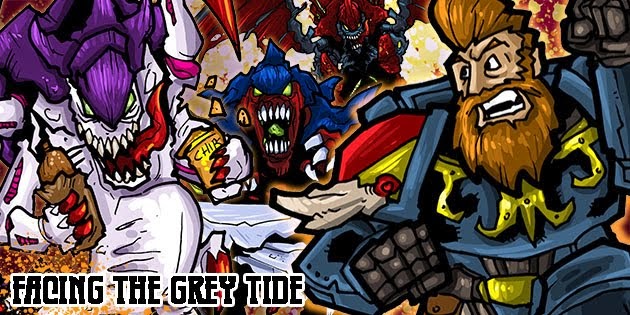You may or may not remember my progress for the last gaming weekend, but to summarize, I didn't get much further than this:
The first project was cutting out another STC, this time for a slightly shorter ruin. A side note - I was using a less than sharp hobby knife and freehanding it, both of which are not advised for best results. That said, when cutting out the basic walls, it's important to bevel cut the sides - this will allow you to connect the corners without exposed foam (which I failed to do on my first assembly.
Once I had the main sections cut out, I cut out the bottom trim and went ahead and glued it. As advised in the instructions, this was cut with a bevel at the top (and extended bevel on the sides to wrap around the corner) so that it would transition into the wall. Once that was attached, I cut out the windows, trying to keep the arch as much as possible rather than ending up with triangles.
The next step was cutting out some card for the decoration on the wall, which is really what will spruce it up a bit. I'd lost my template for this part, so more or less free-handed it. As a result, some of my decorations aren't that pretty, but overall, the effect is good. After attaching the decorative elements, I made a jagged cut toward the middle of the two wall pieces I'd made and then attached the corners to have two ruined corners.
With that, maybe an couple hours' work, I had another ruin. I also cut out some rough floors and roof pieces to add to the building and cap it off. The next step was cutting out some MDF to base this ruin, the old ruin, some old plastic ruins, and so on. For this, a jigsaw and sander are key and make the process pretty quick and painless; I cut and sanded about 8 bases in under a half hour.
Tools of the trade
 |
| Before sanding, just checking the fit. Sanding would help round the corners and remove the ragged edges. |
 |
| When adding the arch cap, putting it upside down helped make sure both sides stuck. |
Next was basing. I went outside for this since I knew I'd be tossing sand all over the place. I applied a generous coat of PVA on the base and in a bunch of the crevices between boulders and then dumped sand over the whole thing.
While out there, I added sand to the base of all the ruins and a couple other pieces, though I started running low on glue, so decided to only do partial coverage.
Finally, with everything ready to go, I used up a fair bit of Black spray paint on the plastic bits, and even gave some test sprays to my foam bits. The white foamcore didn't take any paint and more or less melted the top layer, but the pink foam fared a little better, getting a little pock marked, but not too badly, and I frankly liked the effect. After the spray coat, I dabbed on some exterior paint left over from a house project on exposed spots and the like. I was using a big brush, so couldn't get everywhere, but got the major areas.
And that, unfortunately, is as far as I'll get before our gaming weekend. That said, black terrain is better than pink and white terrain. From here my plan is to use the airbrush to get in the tough to reach areas with the black and then work up the colors (probably mostly grey). Ron's been asking about the airbrush so we might to a hands on tutorial session with the rather forgiving scenery as our test medium.



















No comments:
Post a Comment